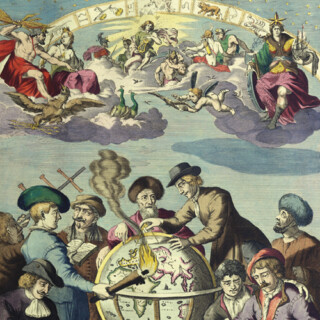Gezicht van's lands of Admiralityts magazyn, en werf, nevens de oorloghschepen leggende in het dok, te zien van het Westindisch Huys naar de Oosterkerk.
Vue du magasin et chantier de l'etat: et aussi des vaissaux de guerre dans le bassin vojant du coté de la maison des indies occidentales, vers l'eglise orientale.
Amsterdam,
Andries and Hendrik de Leth,
[c1730].
Engraving with etching, on two sheets joined.
553 by 905mm (21.75 by 35.75 inches).
14428
notes:
A view along the what is now Prins Hendrikkade (Prince Hendrik quay) with the Zeemagazijn (now the Scheepvaartmuseum) and the naval shipyard to the left and the Oosterkerk to the right.
The views shows off the might of the Dutch Navy with numerous ships of the line in the dockyard. To the right of the dockyard stands the "Admiralityts Magazyn" or Zeemagazijn the Dutch navy's arsenal.. On 12 August 1655, the Admiralty was given the entire western strip of Kattenbu...
The views shows off the might of the Dutch Navy with numerous ships of the line in the dockyard. To the right of the dockyard stands the "Admiralityts Magazyn" or Zeemagazijn the Dutch navy's arsenal.. On 12 August 1655, the Admiralty was given the entire western strip of Kattenbu...
bibliography:
R.W.P. de Vries, auction, 1925: 289.
provenance:







![WINDTER, Johann Wilhelm [after] LAAN, Adolph van der Gezicht van's lands of Admiralityts magazyn, en werf, nevens de oorloghschepen leggende in het dok, te zien van het Westindisch Huys naar de Oosterkerk.](https://i0.wp.com/crouchrarebooks.com/wp-content/uploads/2025/03/14428_1H.jpg?fit=1700%2C1061&ssl=1)
